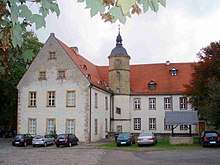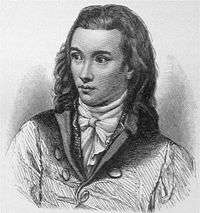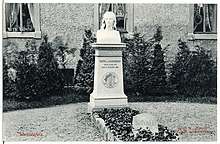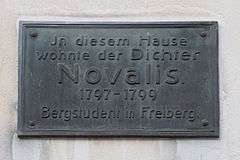Novalis
Novalis (/nəˈvælɪs/; German: [noˈvaːlɪs]) was the pseudonym and pen name of Georg Philipp Friedrich Freiherr von Hardenberg (2 May 1772 – 25 March 1801), a poet, author, mystic, and philosopher of Early German Romanticism. Hardenberg's professional work and university background, namely his study of mineralogy and management of salt mines in Saxony, was often ignored by his contemporary readers. The first studies showing important relations between his literary and professional works started in the 1960s.[2]
Novalis | |
|---|---|
 Novalis (1799), portrait by Franz Gareis | |
| Born | Georg Philipp Friedrich Freiherr von Hardenberg 2 May 1772 Oberwiederstedt, Electorate of Saxony |
| Died | 25 March 1801 (aged 28) Weißenfels, Electorate of Saxony |
| Pen name | Novalis |
| Occupation | Prose writer, poet, mystic, philosopher, civil engineer, mineralogist |
| Nationality | German |
| Alma mater | University of Jena Leipzig University University of Wittenberg |
| Literary movement | Jena Romanticism[1] |
Biography
Early life and education


Georg Philipp Friedrich von Hardenberg was born in 1772 at Oberwiederstedt, a chateau in the present-day town of Arstein, on the eastern edge of the Harz Mountains. In the church in Wiederstedt, he was christened Georg Philipp Friedrich. An oil painting and a christening cap commonly assigned to him are Hardenberg's only possessions now extant.
The family seat was a manorial estate. Hardenberg descended from ancient, Lower German nobility with its ancestral seat at Nörten-Hardenberg since 1287 to this day. Different lines of the family include such important, influential magistrates and ministry officials as the Prussian chancellor Karl August von Hardenberg (1750–1822). He spent his childhood on the family estate and used it as the starting point for his travels into the Harz mountains.
Novalis' father, the estate owner and salt-mine manager Heinrich Ulrich Erasmus Freiherr (Baron) von Hardenberg, was a strictly pietistic man, member of the Moravian (Herrnhuter) Church. His mother was Auguste Bernhardine (née von Böltzig), who was Heinrich's second wife. She gave birth to eleven children, Georg Philipp Friedrich being the second. The Hardenbergs were an established noble family, but not wealthy. Young Georg Philipp was often short of cash, rode a small horse, and sometimes went about on foot.[3]
At first, young Hardenberg was taught by private tutors. He attended the Lutheran grammar school in Eisleben, where he acquired skills in rhetoric and ancient literature, common parts of the education of his time. From his twelfth year, he was in the charge of his uncle Friedrich Wilhelm Freiherr von Hardenberg at his estate in Lucklum .[4]
Studies and employment
Young Hardenberg studied law from 1790 to 1794 at Jena, Leipzig and Wittenberg. He passed his exams with distinction. During his studies, he attended Schiller's lectures on history and befriended him during his illness. He also met Goethe, Herder and Jean Paul, and befriended Ludwig Tieck, Friedrich Wilhelm Joseph Schelling, and the brothers Friedrich and August Wilhelm Schlegel.
In October 1794, he started working as actuary for August Coelestin Just, who became not only his friend but, later, also his biographer. The following January, he was appointed auditor to the salt works at Weißenfels.
Sophie
During the time he worked for August Coelestin Just, Novalis met the 12-year-old Sophie von Kühn (1782–1797), a girl who was, according to accounts, a "perfectly commonplace young girl, neither intelligent nor particularly beautiful."[3] Nonetheless, he fell in love with Sophie, since in the young Georg Philipp's view of the world "nothing is commonplace" because "all, when rightly seen, is symbolic."[3] On 15 March 1795, when Sophie was 13 years old, the two became engaged, despite her family's reluctance and the fact that she was already tubercular.[3]
The early death of Sophie in March 1797, from tuberculosis, affected Novalis deeply and permanently. She was only 15 years old, and the two had not married.
At the Mining Academy of Freiberg
In 1795–1796, Novalis entered the Mining Academy of Freiberg in Saxony, a leading academy of science, to study geology under Professor Abraham Gottlob Werner (1750–1817), who befriended him. During Novalis' studies in Freiberg, he immersed himself in a wide range of studies, including mining, mathematics, chemistry, biology, history and, not least, philosophy. It was here that he collected materials for his encyclopaedia project, Das allgemeine Brouillon. Similar to other German authors of the Romantic age, his work in the mining industry, which was undergoing then the first steps to industrialization, was closely connected with his literary work.[5]
Literary and philosophical connections
In the period 1795–1796, Novalis concerned himself with the philosophical doctrine of Johann Gottlieb Fichte, which greatly influenced his worldview. He not only read Fichte's philosophies but also developed his concepts further, transforming Fichte's Nicht-Ich (German "not I") to a Du ("you"), an equal subject to the Ich ("I"). This was the starting point for Novalis' Liebesreligion ("religion of love").
Novalis' first fragments were published in 1798 in the Athenäum, a magazine edited by the Schlegel brothers, who were also part of the early Romantic movement. Novalis' first publication was entitled Blüthenstaub (Pollen) and saw the first appearance of his pseudonym, "Novalis". In July 1799, he became acquainted with Ludwig Tieck, and that autumn he met other authors of so-called "Jena Romanticism".
Julie
Novalis became engaged for the second time in December 1798. His fiancée was Julie von Charpentier (1776–1811), a daughter of Johann Friedrich Wilhelm Toussaint von Charpentier, a professor in Freiberg.
From Pentecost 1799, Novalis again worked in the management of salt mines. That December, he became an assessor of the salt mines and a director. On the 6 December 1800, the twenty-eight-year-old Hardenberg was appointed Supernumerar-Amtshauptmann for the district of Thuringia, a position comparable to a present-day magistrate.
Death
From August 1800 onward, Hardenberg was suffering from tuberculosis. On 25 March 1801, he died in Weißenfels.[4] His body was buried in the old cemetery there.
Novalis lived long enough to see the publication only of Pollen, Faith and Love or the King and the Queen and Hymns to the Night. His unfinished novels Heinrich von Ofterdingen and The Novices at Sais, his political speech Christendom or Europa, and numerous other notes and fragments were published posthumously by his friends Ludwig Tieck and Friedrich Schlegel.
Writing
Young Hardenberg adopted the pen name "Novalis" from his 12th-century ancestors who named themselves de Novali, after their settlement Grossenrode, or magna Novalis.[6]
Novalis, who was deeply read in science, law, philosophy, politics and political economy, started writing quite early. He left an abundance of notes on these fields and his early work displays his ease and familiarity with them. His later works are closely connected to his studies and his profession. Novalis collected everything that he had learned, reflected upon it and drew connections in the sense of an encyclopaedic overview on art, religion and science. These notes from the years 1798 and 1799 are called Das allgemeine Brouillon (literally "general rough draft"), now available in English under the title Notes for a Romantic Encyclopaedia.[7] Together with Friedrich Schlegel, Novalis developed the fragment as a literary artform. The core of Hardenberg's literary works is the quest for the connection of science and poetry, and the result was supposed to be a "progressive universal poesy”.[8] Novalis was convinced that philosophy and the higher-ranking poetry have to be continually related to each other.[9]
The fact that the romantic fragment is an appropriate form for a depiction of "progressive universal poesy”, can be seen especially from the success of this new genre in its later reception.
Novalis' whole works are based upon an idea of education: "We are on a mission: we are called upon to educate the earth."[10] It has to be made clear that everything is in a continual process. It is the same with humanity, which forever strives towards and tries to recreate a new Golden Age – a paradisaic Age of harmony between man and nature that was assumed to have existed in earlier times. This Age was described by Plato, Plotinus and Frans Hemsterhuis, the last of whom was an extremely important figure for the German Romantics.
This idea of a romantic universal poesy can be seen clearly in the romantic triad. This theoretical structure always shows its recipient that the described moment is exactly the moment (kairos) in which the future is decided. These frequently mentioned critical points correspond with the artist's feeling for the present, which Novalis shares with many other contemporaries of his time. Thus a triadic structure can be found in most of his works. This means that there are three corresponding structural elements which are written differently concerning the content and the form.
Hardenberg's intensive study of the works of Jakob Böhme, from 1800, had a clear influence on his own writing.[11]
A mystical worldview, a high standard of education, and the frequently perceptible pietistic influences are combined in Novalis' attempt to reach a new concept of Christianity, faith and God. He forever endeavours to align these with his own view of transcendental philosophy, which acquired the mysterious name "magical idealism",[12] drawing heavily from the critical or transcendental idealism of Immanuel Kant and J. G. Fichte (the earliest form of German idealism), and incorporates the artistic element central to Early German Romanticism. The subject must strive to conform the external, natural world to its own will and genius; hence the term "magical".[13] At the same time, Novalis' emphasis on the term "magic" represents a challenge to what he perceived as the disenchantment that came with modern rationalistic thinking and therefore functions as a "solution" of sorts to the lamentation in Hymnen an die Nacht.[14] David Krell calls magical idealism "thaumaturgic idealism."[15] This view can even be discerned in more religious works such as the Spiritual Songs (published 1802), which soon became incorporated into Lutheran hymn-books.
Novalis influenced, among others, the novelist and theologian George MacDonald, who translated his 'Hymns to the Night' in 1897.[16] More recently, Novalis, and the Early Romanticism (Frühromantik) movement as a whole, has been recognized as constituting a separate philosophical school, as opposed to simply a literary movement.[17] Recognition of the distinctness of Frühromantik philosophy is owed largely, in the English speaking world at least, to the writer Frederick Beiser.[18]
The philosopher and esotericist Rudolf Steiner spoke in various lectures (now published) about Novalis.[19]
Poetry
In August 1800, eight months after completion, the revised edition of the Hymnen an die Nacht was published in the Athenaeum. They are often considered to be the climax of Novalis’ lyrical works and the most important poetry of the German early Romanticism.

The six hymns contain many elements which can be understood as autobiographical. Even though a lyrical "I", rather than Novalis himself, is the speaker, there are many relationships between the hymns and Hardenberg's experiences from 1797 to 1800.
The topic is the romantic interpretation of life and death, the threshold of which is symbolised by the night. Life and death are – according to Novalis – developed into entwined concepts. So in the end, death is the romantic principle of life.
Influences from the literature of that time can be seen. The metaphors of the hymns are closely connected to the books Novalis had read at about the time of his writing of the hymns. These are prominently Shakespeare’s Romeo and Juliet (in the translation by A.W. Schlegel, 1797) and Jean Paul’s Unsichtbare Loge (1793).
The Hymns to the Night display a universal religion with an intermediary. This concept is based on the idea that there is always a third party between a human and God. This intermediary can either be Jesus – as in Christian lore – or the dead beloved as in the hymns. These works consist of three times two hymns. These three components are each structured in this way: the first hymn shows, with the help of the Romantic triad, the development from an assumed happy life on earth through a painful era of alienation to salvation in the eternal night; the following hymn tells of the awakening from this vision and the longing for a return to it. With each pair of hymns, a higher level of experience and knowledge is shown. Some of the poems notably lament the historical replacement of European Paganism by Christianity, creating ambiguity about the exact view of the Hymns on Christianity and polytheism.[20]
Prose
The novel fragments Heinrich von Ofterdingen and Die Lehrlinge zu Sais (The Novices of Sais) reflect the idea of describing a universal world harmony with the help of poetry. The novel 'Heinrich von Ofterdingen' contains the "blue flower", a symbol that became an emblem for the whole of German Romanticism. Originally the novel was supposed to be an answer to Goethe’s Wilhelm Meister, a work that Novalis had read with enthusiasm but later on judged as being highly unpoetical. He disliked the victory of the economical over the poetic.

The speech called Die Christenheit oder Europa was written in 1799, but was first published in 1826. It is a poetical, cultural-historical speech with a focus on a political utopia with regard to the Middle Ages. In this text Novalis tries to develop a new Europe which is based on a new poetical Christendom which shall lead to unity and freedom. He got the inspiration for this text from Schleiermacher’s Über die Religion (1799). The work was also a response to the French Enlightenment and Revolution, both of which Novalis saw as catastrophic and irreligious. It anticipated, then, the growing German and Romantic theme of anti-Enlightenment visions of European spirituality and order.
Influence
Walter Pater includes Novalis's quote, "Philosophiren ist dephlegmatisiren, vivificiren" ("to philosophize is to throw off apathy, to become revived")[21] in his conclusion to Studies in the History of the Renaissance. Novalis' poetry and writings were also an influence on Hermann Hesse.
20th-century German philosopher Martin Heidegger uses a Novalis fragment, "Philosophy is really homesickness, an urge to be at home everywhere" in the opening pages of The Fundamental Concepts of Metaphysics. [22]
Novalis was an influence on Rudolf Steiner.[23]
The libretto of Richard Wagner's opera Tristan und Isolde contains strong allusions to Novalis' symbolic language, especially the dichotomy between the Night and the Day that animates his Hymns to the Night.
Novalis was also an influence on George MacDonald, and so indirectly on C. S. Lewis, the Inklings, and the whole modern fantasy genre. Borges refers often to Novalis in his work.

Novelist Penelope Fitzgerald's last work, The Blue Flower, is a historical fiction about Novalis, his education, his philosophical and poetic development, and his romance with Sophie.
The krautrock band Novalis, beside taking their name from him, adapted or used directly poems by Novalis as lyrics on their albums.
The American avant-garde filmmaker Stan Brakhage made the film First Hymn to the Night – Novalis in 1994. The film was issued on Blu-ray and DVD by the Criterion Collection.[24]
In tribute to his writings, Novalis records are produced by AVC Audio Visual Communications AG, Switzerland.
The animated film Novalis, solo-produced by artist/animator Chris Powell, won Best Animation at the Oregon Independent Film Festival in September 2018. The film was in-competition with One Small Step, a studio production that was nominated for an Academy Award. [25]
Collected works

Novalis' works were originally issued in two volumes by his friends Ludwig Tieck and Friedrich Schlegel (2 vols. 1802; a third volume was added in 1846). Editions of Novalis' collected works have since been compiled by C. Meisner and Bruno Wille (1898), by E. Heilborn (3 vols., 1901), and by J. Minor (3 vols., 1907). Heinrich von Ofterdingen was published separately by J. Schmidt in 1876.
Novalis's Correspondence was edited by J. M. Raich in 1880. See R. Haym Die romantische Schule (Berlin, 1870); A. Schubart, Novalis' Leben, Dichten und Denken (1887); C. Busse, Novalis' Lyrik (1898); J. Bing, Friedrich von Hardenberg (Hamburg, 1899), E. Heilborn, Friedrich von Hardenberg (Berlin, 1901).
The German-language, six-volume edition of Novalis works Historische-Kritische Ausgabe - Novalis Schriften (HKA) is edited by Richard Samuel, Hans-Joachim Mähl & Gerhard Schulz. It is published by Kohlhammer Verlag, Stuttgart, 1960–2006.
English translations
Several of Novalis's notebooks and philosophical works or books about Novalis and his work have been translated into English:
- The Birth of Novalis: Friedrich von Hardenberg's Journal of 1797, With Selected Letters and Documents, trans. and ed. Bruce Donehower, State University of New York Press, 2007.
- Classic and Romantic German Aesthetics, ed. Jay Bernstein, Cambridge University Press, 2003. This book is in the same series, the Fichte-Studies and contains a selection of fragments, plus Novalis' Dialogues. Also in this collection are fragments by Schlegel and Hölderlin.
- Fichte Studies, trans. Jane Kneller, Cambridge University Press, 2003. This translation is part of the Cambridge Texts in the History of Philosophy Series.
- Henry von Ofterdingen, trans. Palmer Hilty, Waveland Press, 1990.
- Hymns to the Night, trans. by Dick Higgins, McPherson & Company: 1988. This modern translation includes the German text (with variants) en face.
- Hymns to the Night / Spiritual Songs, Tr. George MacDonald, Foreword by Sergei O. Prokofieff, Temple Lodge Publishing, London, 2001.
- Klingsohr's Fairy Tale, Unicorn Books, Llanfynydd, Carmarthen, 1974.
- Novalis: Notes for a Romantic Encyclopaedia (Das Allgemeine Brouillon), trans. and ed. David W. Wood, State University of New York Press, 2007. First English translation of Novalis's unfinished project for a "universal science," it contains his thoughts on philosophy, the arts, religion, literature and poetry, and his theory of "Magical Idealism." The Appendix contains substantial extracts from Novalis' Freiberg Natural Scientific Studies 1798/1799.
- Novalis: Philosophical Writings, transl. and ed. Margaret Mahoney Stoljar, State University of New York Press, 1997. This volume contains several of Novalis' works, including Pollen or Miscellaneous Observations, one of the few complete works published in his lifetime (though it was altered for publication by Friedrich Schlegel); Logological Fragments I and II; Monologue, a long fragment on language; Faith and Love or The King and Queen, a collection of political fragments also published during his lifetime; On Goethe; extracts from Das allgemeine Broullion or General Draft; and his essay Christendom or Europe.
- The Novices of Sais, trans. by Ralph Manheim, Archipelago Books, 2005. This translation was originally published in 1949. This edition includes illustrations by Paul Klee. The Novices of Sais contains the fairy tale "Hyacinth and Rose Petal."
References
- Joel Faflak, Julia M. Wright (eds.), A Handbook of Romanticism Studies, John Wiley & Sons, 2016, p. 334.
- Barbara Laman, James Joyce and German Theory: The Romantic School and All That, Fairleigh Dickinson University Press, 2004, ISBN 9781611472844, p.37
- "Dark Fates" by Frank Kermode, London Review of Books, 5 October 1995 - reproduced in Kermode's collection Bury Place Papers, LRB, London, 2009, ISBN 9781873092040
- Gjesdal, Kristin (2014), Zalta, Edward N. (ed.), "Georg Friedrich Philipp von Hardenberg [Novalis]", The Stanford Encyclopedia of Philosophy (Fall 2014 ed.), Metaphysics Research Lab, Stanford University, retrieved 30 October 2018
- Theodore Ziolkowski: German Romanticism And Its Institutions, Princeton University Press, 1992
- Novalis in the Literary Encyclopedia, The Literary Dictionary Company
- Kneller, Jane (5 September 2008). "Review of Notes for a Romantic Encyclopaedia: Das Allgemeine Brouillon". ISSN 1538-1617. Cite journal requires
|journal=(help) - "GHDI - Document". ghdi.ghi-dc.org. Retrieved 30 October 2018.
- Moyar, Associate Professor of Philosophy Dean; Moyar, Dean (5 April 2010). The Routledge Companion to Nineteenth Century Philosophy. Routledge. ISBN 9781135151119.
- Nassar, Dalia (24 December 2013). The Romantic Absolute: Being and Knowing in Early German Romantic Philosophy, 1795-1804. University of Chicago Press. ISBN 9780226084237.
- Mayer, Paola (26 November 1999). Jena Romanticism and Its Appropriation of Jakob Bšhme: Theosophy, Hagiography, Literature. McGill-Queen's Press - MQUP. ISBN 9780773518520.
- Warnes, Christopher (2006). "Magical Realism and the Legacy of German Idealism". The Modern Language Review. 101 (2): 488–498. doi:10.2307/20466796. JSTOR 20466796.
- See David W. Wood's introduction to the entry for "Novalis," Notes for a Romantic Encyclopaedia, Albany: SUNY, 2007
- Josephson-Storm, Jason (2017). The Myth of Disenchantment: Magic, Modernity, and the Birth of the Human Sciences. Chicago: University of Chicago Press. p. 88. ISBN 978-0-226-40336-6.
- David Farrell Krell, Contagion, Indianapolis: Indiana State University, 1998.
- "Novalis". www.george-macdonald.com. Retrieved 30 October 2018.
- Beiser, Frederick C. (2003). The Romantic Imperative. Harvard University Press. ISBN 9780674011809.
- Rush, Fred (2005). "Review of The Romantic Imperative: The Concept of Early German Romanticism". Mind. 114 (455): 709–713. doi:10.1093/mind/fzi709. JSTOR 3489014.
- "Novalis". 2015. Retrieved 29 November 2017.
- Josephson-Storm (2017), p. 76-7.
- Barbara Laman, James Joyce and German Theory: "The Romantic School and All That", (Fairleigh Dickinson University Press, 2004), 37.
- Heidegger, Martin (1 March 2001). The Fundamental Concepts of Metaphysics: World, Finitude, Solitude. Translated by McNeill, William; Walker, Nicholas (Reprint ed.). Bloomington, Ind: Indiana University Press. ISBN 9780253214294.
- Steiner, Dr Rudolf; Mansell, Rick (2008). Tazo (ed.). The Significance of Novalis - A Lecture By Rudolf Steiner - A TAZO EDITION. Rosenkreutz Institute.
- By Brakhage: An Anthology, Volumes One and Two, Criterion
- ,
Further reading
- Ameriks, Karl (ed.). The Cambridge Companion to German Idealism. Cambridge: Cambridge University Press, 2000
- Arena, Leonardo Vittorio, La filosofia di Novalis, Milano: Franco Angeli, 1987 (in Italian)
- Behler, Ernst. German Romantic Literary Theory. Cambridge: Cambridge University Press, 1993
- Beiser, Frederick. German Idealism. Cambridge: Harvard University Press, 2002
- Berman, Antoine. L'épreuve de l'étranger. Culture et traduction dans l'Allemagne romantique: Herder, Goethe, Schlegel, Novalis, Humboldt, Schleiermacher, Hölderlin., Paris, Gallimard, Essais, 1984. ISBN 978-2-07-070076-9 (in French)
- Fitzgerald, Penelope. The Blue Flower. Mariner Books, 1995. A novelization of Novalis' early life.
- Haywood, Bruce. Novalis, the veil of imagery; a study of the poetic works of Friedrich von Hardenberg, 1772–1801, 's-Gravenhage, Mouton, 1959; Cambridge, Mass.: Harvard University Press, 1959.
- Krell, David Farrell. Contagion. Bloomington: Indiana University Press, 1998.
- Kuzniar, Alice. Delayed Endings. Georgia: University of Georgia Press, 1987.
- Lacoue-Labarthe, Phillipe and Jean-Luc Nancy. The Literary Absolute. Albany: State University of New York Press, 1988.
- Molnár, Geza von. Novalis' "Fichte Studies".
- O’Brien, William Arctander. Novalis: Signs of Revolution. Durham: Duke University Press, 1995. ISBN 0-8223-1519-X
- Pfefferkorn, Kristin. Novalis: A Romantic's Theory of Language and Poetry. New Haven: Yale University Press, 1988.
- Prokofieff, Sergei O. Eternal Individuality. Towards a Karmic Biography of Novalis. Temple Lodge Publishing, London 1992.
External links
| Wikiquote has quotations related to: Novalis |
| Wikisource has the text of a 1920 Encyclopedia Americana article about Novalis. |
- Works by Novalis at Project Gutenberg
- Works by or about Novalis at Internet Archive
- Works by Novalis at LibriVox (public domain audiobooks)

- Novalis by Anna Ezekiel, Internet Encyclopedia of Philosophy
- Novalis by Kristin Gjesdal, Stanford Encyclopedia of Philosophy
- Novalis: Hymns to The Night – a translation of the work by George MacDonald
- Novalis Online – including a few (computer-generated) hybrid-English translations, and essays on and by Novalis.
- Oberwiederstedt Manor, birthplace of Novalis and home to the International Novalis Society and the Novalis Foundation (in German)
- Aquarium: Friedrich von Hardenberg im Internet – a highly useful multi-lingual web-site for information on Novalis. It provides updates and news in English, German, French, Spanish and Italian, on the latest Novalis translations and reviews, along with general discussions, odd trivia and scholarly articles.
- . New International Encyclopedia. 1905.
- . Encyclopædia Britannica (11th ed.). 1911.
- Excerpts from Henry of Ofterdingen with illustrations (mostly paintings by Caspar David Friedrich)